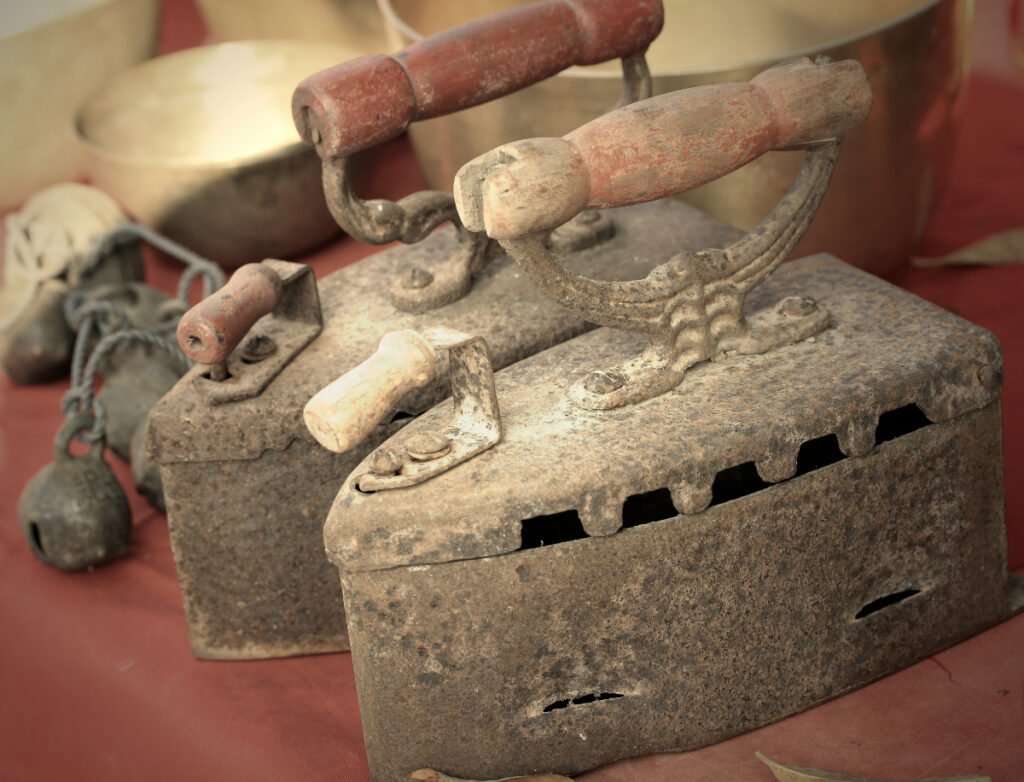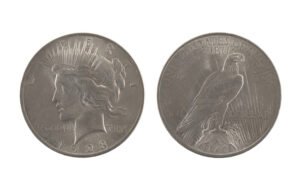Do you know that antique sad irons cost twice that of clothes irons? Now, you may ask why. Well, although a vintage sad iron neither irons clothes nor reduces burns, it flaunts those pure iron bodies that you don’t see today! So, sad irons actually make antique collectors happy!
But hey! People love antiques for their handmade finishes, right? So, how will you get good returns if they don’t see those old features? Don’t worry! Today, I’ll help you spot and price these features and much more in this vintage sad iron value guide!
Key Takeaways
- Get sad irons with cased iron handles, rivets, and holders for an old local make. And if you want foreign ones, pick those from France or Bulgaria for good returns.
- You can heat your old sad iron in three ways – charcoal, fuel, and wood. Of these, the charcoal and fuel ones are more costly!
- Pick sad irons with iron, wood, or ceramic handles for an old make.
- Check if your iron’s handle has flat, round, animal, or bird shapes. If not, it might be a new, forged model.
Special Features of Old Vintage Sad Irons

Unscrew your sad iron base and see if it has oil or fuel space. Also, count the number of chambers! If there are 1 – 3 chambers, it’s an antique sad iron, costing $500 – 600. If not, it just might be any cheap gasoline iron. Also, look for the carvings on top!
But if the carvings are rusty, here are other details to look for:
- Handles with wrought iron cores, cased with cast iron, fiber, or cellulose sheets
- 5 – 6 bottom holes to direct air to the iron’s core
- Smooth faces with pointed ends and flat/polished edges
- Floral or animal-carved metal rivets with a 5 – 9 pound holder base and stand
How Did Antique Sad Irons Evolve?
Look at any Stone Age-era tools! They have crude, beaten bodies, right? Well, it’s the same with old sad irons. In fact, most of them look like old skillets with flat lids and fuel tanks. You’ll also see bare, burning hot iron handles! So, they literally made users cry in pain!
It was in the 1800s that John Alexander solved this! He added removable wooden handles and curved tips for better heating. But, these handles were fragile and didn’t fit onto different iron models. So, people stopped using them, making them rare today!

Then, entered Mary Potts in the 1900s. And as she faced this problem herself, she knew what to do! For instance, she used attached handles, pointed ends, and plaster to reduce the iron’s weight. But this process was machine-made, making these irons relatively cheaper!
8 Steps to Identify & Value an Antique Sad Iron
Did you figure out your sad iron’s base price from the list above? If yes, let’s jump onto the details to calculate its actual cost! Shall we?
1. Find Its Manufacturing Date & Age
If you want the old, fast-reselling models, the 1700s sad irons are best! But, if the burning handles haunt you, get the 1800s ones for daily use. And if you want portable, lightweight models, what’s better than the 1900s ones? But yes, these are common and cheap!
But what if you don’t see any date stamps on your sad iron? In that case, here’s how to track the age:

How Does a 1700s Sad Iron Look?
Most 1700s sad irons are hand-beaten. So, you’ll see all those old hammer finishes and uneven edges. They are also a bit triangular and have single metal handles and rivets. Next, check their weight; if they weigh 6 – 9 lbs, they’re old, 1700s models, costing $1000 – 1200.
How Do You Check an 1800s Sad Iron?
Check if your iron has detached handles, stamped rivets, and carved holders. Also, see if it has half-hand and machine bodies. If yes, it’s surely a 1800s iron, costing $500 – 600. Now, check its handles! If they are goose-neck or geometrical, you can hike the cost by 3 – 4%.
How Do You Pick a 1900s Sad Iron?
Look for thin, steel-made irons with flat wooden handles to spot these! You’ll also see pointed ends, rolled edges, and stamped bases with patent numbers. And if your iron has asbestos or insulated handles, it costs $300 – 350. Otherwise, $100 – 120 is enough.
Here are some antique sad iron patent numbers for help!
| Year | Age | Patent Number | Average Valuation |
| 1861 | 162 years | US32304A | $400 – 450 |
| 1947 | 76 years | US2634526A | $100 – 150 |
| 1882 | 141 years | US265281A | $200 – 250 |
| 1906 | 117 years | US864735A | $100 – 120 |
Get sad irons with detachable handles, alcohol fuel tanks, and curved brims for an old make.
2. Examine Its Type
Generally, there are three types of antique sad irons: pan irons, meta-fuel sad irons, and gas lighter sad irons.
Meta-fuel Sad Irons

Does your sad iron measure about 6 – 8 inches? Or does it have portable gas tanks and canisters? If yes, it’s a meta-fuel sad iron! You’ll also see 5 – 6-inch grips and thick, stamped metal bases with this one! Plus, it comes with wax or lacquer handles, costing $200 – 300.
Vintage Pan Iron
Just as the name says, sad pan irons look like cooking pans. Like, they have flat bases, round walls, lids, and curved handles. Most also come with a 3-chamber alcohol or fuel tank at the top. They weigh about 9 – 10 pounds and cost around $600 – 1000 for their solid bodies.
Gas Lighter Sad Irons

Gas lighter sad irons are portable models with round knobs or rotators. They have smaller fuel tanks and thinner walls than others. Plus, they used gasoline-fueled walls and pipes, costing $400 – 500. You can also check their bases for stamped logos and marks.
3. Observe the Handle Shape
Sad iron bases are always triangular or curved. So, it’s the handle shape that impacts its resale value. Like, irons with flat or curved handles sell fast. Those with brims or caps come next. Similarly, animal or bird-shaped handles are best if you eye a foreign make!
Here’s how much money you’ll make for some sad iron handle shapes:
| Old Sad Iron Handle Shapes | Average Valuation |
| Flat, Rectangular, or Barrel | $400 – 500 |
| Round, Tubular, or Chiseled | $300 – 400 |
| Cap, Hat, or Brim Shaped | $250 – 300 |
| Birds – Swan, Goose, or Rooster | $200 – 300 |
| Animals – Monkey, Lion, or Snail | $200 – 300 |
| Bench or Arch Shaped | $100 – 120 |
| Cabinet Handle or Knob-Shaped | $50 – 60 |
4. Check the Handle Materials

If you want old, handmade irons, pick the ones with cased metal or wood handles. You might even see sad irons with ceramic or plastic handles at the shop. But those are new and cheap. Similarly, vintage irons with plastic or fiber handles are a big no for good returns!
| Old Sad Iron Handle Materials | Average Valuation |
| Cast Iron, Zinc, or Titanium | $200 – 250 |
| Alloyed & Carbide Steel | $150 – 200 |
| Wood – Ash, Maple & Cherry | $100 – 120 |
| Ceramic & Terracotta | $80 – 90 |
| Stainless Steel & Fiber | $50 – 60 |
| Plastic & Aluminum | $20 – 30 |
Pick sad irons with oxidized, lacquered, or waxed handles for a precious, handmade finish.
5. Check its Brands

Not sure of your sad iron’s age and brand? Well, just rotate it and see if you see any embossed logos, marks, or signs to know the brand! Now, you just have to refer to the brand’s catalog to know its value! You can also look for gold or silver handles to hike costs.
Here are some vintage sad iron brands to collect:
| Old Sad Iron Name | Manufacturer | Antique Sad Iron Type | Average Valuation |
| Chinatown Sad Iron | FY LUNG KEE | Meta-fuel Iron | $1000 – 1200 |
| Chimney Wood Sad Iron | Brevetto FW4 | Charcoal Sad Iron | $650 – 700 |
| German Sad Iron | Alexanderwerk | Meta-fuel Iron | $600 – 650 |
| No.6 French Sad Iron | Le Gaulois Gallic | Fuel Iron | $300 – 400 |
Avoid buying chipped, cracked, or rusted sad irons as they might lose their value by 8 – 9%.
6. Observe the Colors

You’ll get antique sad irons in two colors – bare material and painted. Of these, natural brown, gray, or bronze irons are precious, costing $300 – 350. On the other hand, painted red, white, or black finishes are a bit more common and cheaper, up to $150.
Avoid getting sad irons with red or yellow handles, as those might be new and galvanized.
7. Analyse Its Style

Vintage sad iron makers were all around the globe! So, each explored different designs, motifs, and carvings. The French ones, for instance, are portable and minimal. But those from Bulgaria are large, stamped, and intricately carved. So, they cost more!
Want to know the average value for each vintage sad iron style? Here’s a list to help!
| Old Sad Iron Style | Average Valuation |
| French or Primitive | $300 – 350 |
| Chinese or Asian | $700 – 900 |
| Bulgaria | $400 – 450 |
| Japanese or Modern | $120 – 150 |
Get sad irons with regional dragon, berry, or animal-carved handles for a foreign make.
8. Check Its Heating Chambers
Unscrew your sad iron’s base and check its chamber. If it looks sooty, it might have charcoal chambers, costing $600. If you see shallow, round sections, it might be a fuel or alcohol sad iron, costing $400 – 500. But, if it’s deep, it might be wooden, costing up to $300.
How Do You Clean a Rusty Sad Iron?
Make a thin paste of salt, lemon juice, and vinegar, and scrub the base with a soft toothbrush. Next, rinse the sad iron with soap, water and dab it with paper towels. Leave it in the air for 4-5 hours; now, it’s ready for storage.
When Did Makers Stop Making Antique Sad Irons?
Makers stopped making antique sad irons by the late 1950s. So, if your model has a later date, it might be forged and cheap.
Why Is a Sad Iron Called Sad?
Sad irons are called ‘sad’ due to their full metal bodies that burn the fingers of the person using them! Plus, they were also heavy and difficult to move. So people weren’t comfortable using them.
Valuing rare, difficult-to-get antiques like sad irons is no longer tedious! All you have to do is dust the piece, check its materials, age, and shape, and add the values! Also, don’t forget to check their logos and brands to hike the costs!
Try to get sad irons with controllable fuel or charcoal ignitors for easy use. But if you don’t get those, you can even heat your iron in any antique wood stove! So, jump onto our guide on ‘Antique Wood Stoves’ to learn more!
Note: This article is intended for informational, educational, and entertainment purposes only. Some images are illustrative and may not represent actual brands, products, or related entities. All trademarks, product names, brand logos, packaging, and other intellectual property referenced remain the exclusive property of their respective owners. Any brand mentions or references are provided solely for descriptive and educational context and do not imply any formal or commercial association.










